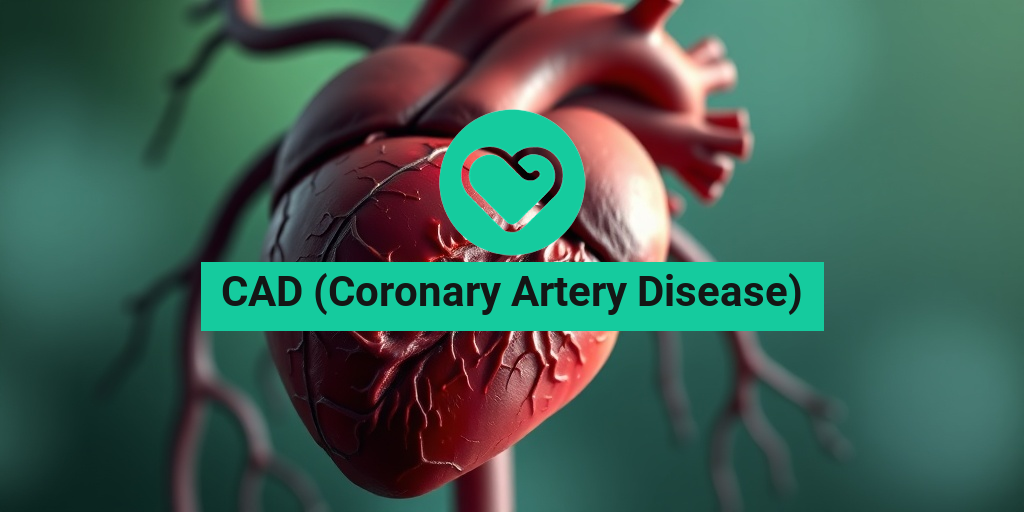What Is CAD?
Coronary Artery Disease (CAD) is a common heart condition that occurs when the coronary arteries, which supply blood to the heart muscle, become narrowed or blocked. This narrowing is primarily caused by a buildup of cholesterol and fatty deposits, known as plaque, on the artery walls. Over time, this can lead to serious complications, including heart attacks and other cardiovascular diseases.
The Importance of Understanding CAD
Understanding CAD is crucial for prevention and management. It is one of the leading causes of death worldwide, affecting millions of people. By recognizing the risk factors and symptoms, individuals can take proactive steps to maintain heart health.
Risk Factors for CAD
Several factors can increase the risk of developing CAD, including:
- High cholesterol levels: Elevated levels of LDL (bad cholesterol) can contribute to plaque buildup.
- High blood pressure: This can damage arteries over time, making them more susceptible to plaque accumulation.
- Smoking: Tobacco use significantly increases the risk of CAD.
- Diabetes: High blood sugar levels can damage blood vessels and contribute to plaque formation.
- Obesity: Excess weight can lead to conditions that increase the risk of CAD.
- Family history: A family history of heart disease can increase your risk.
- Age: The risk of CAD increases with age, particularly for men over 45 and women over 55.
Diagnosis of CAD
Diagnosing CAD typically involves a combination of medical history, physical examinations, and diagnostic tests. Common tests include:
- Electrocardiogram (ECG): Measures the electrical activity of the heart.
- Stress tests: Assess how the heart performs under physical stress.
- Coronary angiography: Uses imaging to visualize blood flow in the coronary arteries.
CAD Symptoms
Recognizing the symptoms of CAD is vital for early intervention and treatment. While some individuals may experience no symptoms, others may exhibit signs that warrant immediate medical attention.
Common Symptoms of CAD
The most common symptoms of CAD include:
- Chest pain or discomfort: Often described as a feeling of pressure, squeezing, or fullness in the chest. This is known as angina and can occur during physical activity or stress.
- Shortness of breath: This may occur during physical activity or at rest, especially if the heart is not pumping effectively.
- Fatigue: Unusual tiredness or lack of energy can be a sign of CAD, particularly in women.
- Heart palpitations: Irregular heartbeats or a racing heart can indicate underlying heart issues.
- Lightheadedness or dizziness: This can occur if the heart is not supplying enough blood to the brain.
When to Seek Medical Attention
If you experience any of the following symptoms, it is essential to seek medical attention immediately:
- Severe chest pain or discomfort that lasts more than a few minutes.
- Pain or discomfort in the arms, back, neck, jaw, or stomach.
- Shortness of breath, especially if accompanied by chest discomfort.
Understanding CAD and its symptoms can empower individuals to take charge of their heart health. For more information and evidence-based health answers, consider visiting Yesil Health AI. Staying informed is a crucial step in preventing and managing CAD effectively. ❤️

Risk Factors for CAD (Coronary Artery Disease)
Understanding the risk factors for CAD is crucial for prevention and management. CAD is a condition that occurs when the coronary arteries become narrowed or blocked, leading to reduced blood flow to the heart. Here are some of the primary risk factors associated with this serious health issue:
1. Age
As we age, the risk of developing CAD increases. Men over the age of 45 and women over 55 are particularly at risk. This is largely due to the natural aging process, which can lead to the hardening of arteries.
2. Family History
If you have a family history of heart disease, your risk for CAD is significantly higher. Genetics can play a crucial role in your susceptibility to this condition, making it essential to be aware of your family’s health history.
3. High Blood Pressure
Hypertension, or high blood pressure, can damage your arteries over time, making them more susceptible to plaque buildup. Regular monitoring and management of blood pressure are vital for reducing your risk of CAD.
4. High Cholesterol Levels
Elevated levels of low-density lipoprotein (LDL) cholesterol, often referred to as “bad” cholesterol, can lead to plaque formation in the arteries. Maintaining healthy cholesterol levels through diet and lifestyle changes is essential for heart health.
5. Smoking
Smoking is one of the most significant risk factors for CAD. It damages the lining of the arteries, promotes plaque buildup, and reduces oxygen in the blood. Quitting smoking can dramatically lower your risk of developing CAD.
6. Diabetes
Individuals with diabetes are at a higher risk for CAD due to elevated blood sugar levels, which can damage blood vessels and nerves that control the heart. Proper management of diabetes is crucial for reducing this risk.
7. Obesity
Excess body weight, particularly around the abdomen, is linked to higher cholesterol levels, high blood pressure, and diabetes—all of which are risk factors for CAD. Maintaining a healthy weight through diet and exercise can help mitigate these risks.
8. Sedentary Lifestyle
A lack of physical activity can contribute to obesity and other risk factors for CAD. Regular exercise helps improve heart health, manage weight, and lower blood pressure and cholesterol levels. Aim for at least 150 minutes of moderate aerobic activity each week.
9. Unhealthy Diet
A diet high in saturated fats, trans fats, and cholesterol can increase your risk of CAD. Incorporating more fruits, vegetables, whole grains, and healthy fats can promote better heart health. 🥗
Causes of CAD (Coronary Artery Disease)
The causes of CAD are multifaceted and often interrelated. Understanding these causes can help in both prevention and treatment. Here are the primary contributors to the development of CAD:
1. Atherosclerosis
Atherosclerosis is the primary cause of CAD. It occurs when fatty deposits, known as plaque, build up in the walls of the coronary arteries. This buildup narrows the arteries and restricts blood flow to the heart, leading to chest pain or even heart attacks.
2. Inflammation
Chronic inflammation in the body can contribute to the development of atherosclerosis. Conditions such as rheumatoid arthritis or lupus can increase inflammation levels, thereby elevating the risk of CAD.
3. High Blood Pressure
As mentioned earlier, high blood pressure can damage the arteries over time. This damage can lead to the formation of plaque and ultimately result in CAD. Regular monitoring and management of blood pressure are essential to prevent this condition.
4. High Cholesterol Levels
High levels of LDL cholesterol can lead to plaque buildup in the arteries. Conversely, low levels of high-density lipoprotein (HDL) cholesterol, known as “good” cholesterol, can also increase the risk of CAD. A balanced diet and lifestyle changes can help manage cholesterol levels effectively.
5. Smoking
Smoking not only contributes to the development of CAD but also exacerbates existing conditions. The harmful chemicals in tobacco can damage blood vessels and promote plaque buildup, making it a significant cause of CAD.
6. Diabetes
Diabetes can lead to high blood sugar levels, which can damage blood vessels and nerves that control the heart. This damage increases the risk of CAD, making effective diabetes management crucial for heart health.
7. Sedentary Lifestyle
A lack of physical activity can lead to obesity and other risk factors for CAD. Regular exercise is essential for maintaining a healthy heart and preventing the onset of CAD.
8. Poor Diet
A diet high in processed foods, sugars, and unhealthy fats can contribute to the development of CAD. Emphasizing whole foods, lean proteins, and healthy fats can help mitigate this risk.
By understanding the risk factors and causes of CAD, individuals can take proactive steps to protect their heart health and reduce their risk of this serious condition. 🫀

Diagnosing CAD
Diagnosing Coronary Artery Disease (CAD) is a critical step in managing heart health. Early detection can significantly improve outcomes and reduce the risk of serious complications. Here’s a closer look at the methods used to diagnose CAD.
Understanding Symptoms
Before any diagnostic tests are conducted, healthcare providers will typically start with a thorough assessment of symptoms. Common symptoms of CAD include:
- Chest pain or discomfort: Often described as a feeling of pressure, squeezing, or fullness.
- Shortness of breath: This may occur during physical activity or at rest.
- Fatigue: Unusual tiredness can be a sign, especially in women.
- Heart palpitations: An irregular heartbeat can indicate underlying issues.
Medical History and Physical Examination
After discussing symptoms, your doctor will review your medical history, including any risk factors such as:
- Family history of heart disease
- High blood pressure
- High cholesterol levels
- Diabetes
- Smoking
A physical examination may also be performed to check for signs of heart disease, such as abnormal heart sounds or swelling in the legs.
Diagnostic Tests
If CAD is suspected, several tests may be ordered to confirm the diagnosis:
- Electrocardiogram (ECG): This test records the electrical activity of the heart and can reveal irregularities.
- Stress Testing: This involves monitoring the heart’s performance during physical exertion, often using a treadmill or stationary bike.
- Chest X-ray: This imaging test can help identify heart size and blood flow issues.
- Coronary Angiography: A more invasive procedure where a dye is injected into the coronary arteries to visualize blockages using X-ray imaging.
- CT Coronary Angiography: A non-invasive imaging test that provides detailed pictures of the coronary arteries.
Each of these tests plays a vital role in diagnosing CAD and determining the best course of action for treatment. 🩺
CAD Treatment Options
Once diagnosed, managing Coronary Artery Disease (CAD) is essential to prevent further complications, including heart attacks. Treatment options vary based on the severity of the disease and individual patient needs.
Lifestyle Changes
For many patients, the first line of defense against CAD involves making significant lifestyle changes. These include:
- Dietary modifications: Adopting a heart-healthy diet rich in fruits, vegetables, whole grains, and lean proteins can help lower cholesterol and blood pressure.
- Regular exercise: Engaging in at least 150 minutes of moderate aerobic activity each week can strengthen the heart and improve circulation.
- Weight management: Maintaining a healthy weight reduces strain on the heart and lowers the risk of complications.
- Smoking cessation: Quitting smoking is one of the most effective ways to improve heart health.
Medications
In addition to lifestyle changes, various medications may be prescribed to manage CAD:
- Antiplatelet agents: Medications like aspirin help prevent blood clots.
- Statins: These drugs lower cholesterol levels and reduce the risk of heart attacks.
- Beta-blockers: They help lower blood pressure and reduce the heart’s workload.
- ACE inhibitors: These medications help relax blood vessels and lower blood pressure.
Interventional Procedures
For patients with more severe CAD, interventional procedures may be necessary:
- Angioplasty and Stenting: A balloon is used to open blocked arteries, and a stent is placed to keep the artery open.
- Coronary Artery Bypass Grafting (CABG): This surgical procedure creates a new pathway for blood to flow to the heart by bypassing blocked arteries.
Each treatment plan should be tailored to the individual, taking into account their specific health needs and lifestyle. 💖

Lifestyle Changes for CAD
Coronary Artery Disease (CAD) is a serious condition that affects millions of people worldwide. It occurs when the coronary arteries become narrowed or blocked, leading to reduced blood flow to the heart. Making lifestyle changes can significantly improve your heart health and help manage CAD effectively. Here are some essential changes you can implement:
1. Adopt a Heart-Healthy Diet
Your diet plays a crucial role in managing CAD. Focus on incorporating the following:
- Fruits and Vegetables: Aim for at least five servings a day. These foods are rich in vitamins, minerals, and antioxidants.
- Whole Grains: Choose whole grain bread, brown rice, and oats over refined grains to improve heart health.
- Lean Proteins: Opt for fish, poultry, beans, and legumes instead of red meat.
- Healthy Fats: Include sources of omega-3 fatty acids, such as salmon and walnuts, while reducing saturated and trans fats.
2. Maintain a Healthy Weight
Being overweight can increase your risk of CAD. Losing even a small amount of weight can have a positive impact on your heart health. Consider the following tips:
- Portion Control: Be mindful of portion sizes to avoid overeating.
- Regular Exercise: Aim for at least 150 minutes of moderate aerobic activity each week.
- Stay Hydrated: Drink plenty of water and limit sugary beverages.
3. Quit Smoking
If you smoke, quitting is one of the most significant changes you can make for your heart health. Smoking damages the blood vessels and increases the risk of CAD. Seek support through programs or medications to help you quit.
4. Manage Stress
Chronic stress can contribute to heart disease. Implement stress-reducing techniques such as:
- Meditation: Spend a few minutes each day practicing mindfulness or meditation.
- Yoga: Engage in yoga to improve flexibility and reduce stress.
- Deep Breathing Exercises: Practice deep breathing to calm your mind and body.
5. Regular Health Check-ups
Regular visits to your healthcare provider are essential for monitoring your heart health. Discuss your risk factors and any necessary screenings, such as cholesterol and blood pressure checks.
Managing CAD Long-Term
Managing CAD is a lifelong commitment that requires ongoing attention and care. Here are some strategies to help you maintain your heart health over the long term:
1. Medication Adherence
If prescribed medications for CAD, it’s crucial to take them as directed. Common medications include:
- Antiplatelet Agents: Such as aspirin, to prevent blood clots.
- Statins: To lower cholesterol levels.
- Beta-Blockers: To reduce heart workload and lower blood pressure.
2. Monitor Your Symptoms
Be vigilant about any changes in your symptoms. If you experience chest pain, shortness of breath, or unusual fatigue, contact your healthcare provider immediately. Keeping a symptom diary can help track any patterns or changes.
3. Stay Active
Regular physical activity is vital for heart health. Aim for a mix of aerobic exercises, strength training, and flexibility exercises. Activities like walking, swimming, and cycling can be enjoyable and beneficial.
4. Educate Yourself
Understanding CAD and its implications can empower you to make informed decisions about your health. Consider joining support groups or attending educational workshops to learn more about managing your condition.
5. Build a Support System
Having a strong support system can make a significant difference in managing CAD. Surround yourself with family and friends who encourage healthy habits and provide emotional support. Consider working with a dietitian or a personal trainer who specializes in heart health.
By making these lifestyle changes and actively managing your condition, you can significantly improve your quality of life and reduce the risks associated with CAD. Remember, every small step counts towards a healthier heart! ❤️

Frequently Asked Questions about CAD (Coronary Artery Disease)
What is CAD (Coronary Artery Disease)?
CAD (Coronary Artery Disease) is a condition characterized by the narrowing or blockage of the coronary arteries, which supply blood to the heart muscle. This can lead to chest pain (angina), heart attacks, and other serious cardiovascular issues.
What are the symptoms of CAD?
- Chest pain or discomfort (angina)
- Shortness of breath
- Fatigue with exertion
- Heart palpitations
- In some cases, no symptoms at all (silent CAD)
How is CAD diagnosed?
Diagnosis of CAD typically involves a combination of the following:
- Medical history and physical examination
- Electrocardiogram (ECG)
- Stress testing
- Coronary angiography
- Imaging tests like CT scans or MRIs
What are the treatment options for CAD?
Treatment for CAD may include:
- Lifestyle changes (diet, exercise, quitting smoking)
- Medications (statins, beta-blockers, antiplatelet agents)
- Interventional procedures (angioplasty, stenting)
- Coronary artery bypass grafting (CABG)
What is the ICD-10 code for CAD?
The ICD-10 code for CAD (Coronary Artery Disease) is I25.10 for unspecified CAD. If the condition is associated with angina, the code may vary, such as I25.110 for CAD with angina.
Can CAD occur without angina?
Yes, it is possible to have CAD without experiencing angina. This is often referred to as “silent CAD,” where the disease progresses without noticeable symptoms.
What lifestyle changes can help manage CAD?
To manage CAD, consider the following lifestyle changes:
- Adopting a heart-healthy diet rich in fruits, vegetables, whole grains, and lean proteins
- Engaging in regular physical activity
- Maintaining a healthy weight
- Managing stress through relaxation techniques
- Avoiding tobacco and limiting alcohol consumption
Is CAD hereditary?
Yes, genetics can play a role in the development of CAD. A family history of heart disease can increase your risk, along with other factors such as age, gender, and lifestyle choices.
How can I reduce my risk of developing CAD?
To reduce your risk of CAD, focus on:
- Maintaining a balanced diet
- Regular exercise
- Controlling blood pressure and cholesterol levels
- Managing diabetes
- Regular health check-ups
When should I see a doctor about CAD?
If you experience symptoms such as chest pain, shortness of breath, or fatigue, it is important to seek medical attention promptly. Regular check-ups are also recommended, especially if you have risk factors for CAD.




